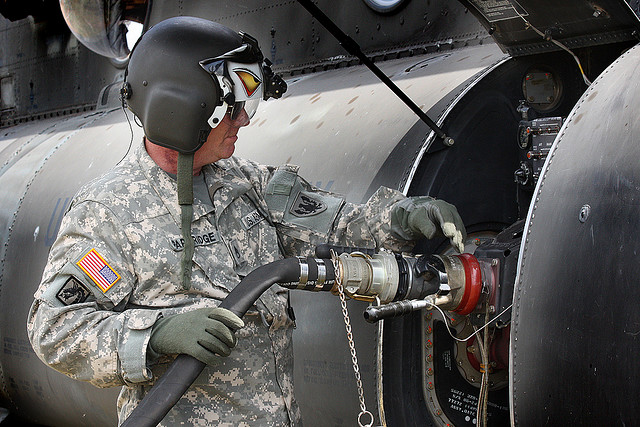The U.S. military’s “going green” is not a singular phenomenon. There are several different things going on under that rubric, with different rationales and different effects. Some of them make such obvious strategic, economic, and environmental sense that no one really can, or does, oppose them. But one in particular — the biofuels initiative — is much less clear-cut. Before discussing that, though, let’s try to pick apart and categorize the green initiatives underway at the Department of Defense.
First off, there are attempts to reduce fossil-fuel use in the theater of war, mainly Iraq and Afghanistan, through more efficiency (insulated tents, LED lights) and the use of distributed renewables. These efforts directly enhance battlefield effectiveness. They make fighting units lighter and faster. They reduce the need for fuel convoys, saving lives and money. They are unimpeachable — even Republicans in Congress will hesitate to second-guess the military’s tactical logistics decisions.
Second, there are attempts to make U.S. military bases more independent of civilian power grids, which are vulnerable to accidents, blackouts, or attacks. In part this is being done by generating power on-site. Solar power for bases has become far more affordable, thanks to plummeting solar-panel prices, but there are also experiments underway with wind, geothermal, and biomass. Bases are also increasing energy and waste efficiency and experimenting with smart microgrids. These efforts seem somewhat more vulnerable to political attack, but I’ve not yet heard of any.
Third, there are efforts to find new liquid fuels for the military’s vast land, air, and water fleets. This one is the biggie, from the standpoint of sheer quantities of energy and money. It’s the most difficult. And it’s also the most controversial, in terms of Republican opposition and environmental risk.
There’s been work on hybrid military ground vehicles, but as far as I know, there’s no prospect of electricity substantially powering ships, planes, and tanks. There’s also very little being done on natural-gas vehicles for the military, at least that I’ve been able to find.
So that means biofuels. A lot of biofuels. Mind-boggling amounts.
Thus far, the military has been careful to avoid biofuel crops that compete with food crops, which are, as all good Grist readers know, a bane — and, climate-wise, not much better than gasoline. Instead, it is trying to stimulate markets in biofuel alternatives like cooking oil, algae, animal fats, and camelina.
It’s a fascinating and laudable effort, but there are two potential problems. First, all these alternatives are wildly expensive. (The algae fuel is $424 a gallon!) That’s to be expected — they’re all experimental. The military’s theory is that it represents a big enough customer to single-handedly create a market sufficient to drive down the cost to competitive levels.
That’s not entirely crazy. The military is the country’s biggest energy consumer: “In fiscal year 2009, the DOD consumed 932 trillion Btu of site delivered energy at a cost of 13.3 billion dollars.” Roughly three-quarters of that went to “mobility fuels” for the fleets. That’s close to $10 billion a year, or, put another way, 360,000 barrels of oil a day. That’s not enormous on a global level — only about 2 percent of U.S. consumption — but it seems large enough to provide biofuels with a serious kickstart. Innovation is never certain, but the military is going about it in a smart way, from labs to field tests.
Still, fuel costs are squeezing DOD’s budget today (see this new briefing from Third Way). Driving down the costs of biofuel alternatives fast enough, at a large enough scale, would be a stunning and, as far as I know, unprecedented achievement.
Which brings up the other possible problem, which is, what if the effort succeeds? It’s one thing to brew a few hundred thousand gallons of algae fuel. It’s another entirely to brew several billion gallons every year. Is there enough cooking oil in all the world’s McDonalds for that much fuel? Enough space to grow that much camelina? These fuels appear benign in their current small-batch phase, but if they were to scale up that much, that fast, it’s hard to say what kind of environmental or social problems might crop up.
Also, the main problem with oil, from a military strategic standpoint, is not so much anything about oil itself, but just the fact that it so dominates the fuel mix. The military is dependent on a single, volatile supply chain over which it has little control. The best move from a strategic standpoint is to diversify. But what if, at the end of all this, the military just ends up dependent on one or two forms of biofuel, with volatile supply chains of their own?
Even if those fuel supply chains are domestic — even if, by some miracle, enough non-food biofuel can be produced within the U.S. to fuel the military — is it really healthy to have the military so dependent on one or two domestic industries? Those would become industries that, for national-security reasons, can’t be allowed to fail or even substantially shrink. They’d be one more addition to the military-industrial complex, one more advocate for military expansion. It’s a recipe for corruption.
None of this is to say that congressional Republicans are right and DOD should just scrap the whole thing. But it is to say that the biofuels initiative is different from the other military “greening” initiatives, more economically and environmentally fraught. Getting lighter and faster on the battlefield saves money and lives; it is self-justifying. Making military bases more self-sufficient is self-evidently a smart strategic move. But shifting from oil to biofuels on a grand scale is a huge, audacious, expensive, and extremely risky gamble. It absolutely warrants close oversight and public discussion.




